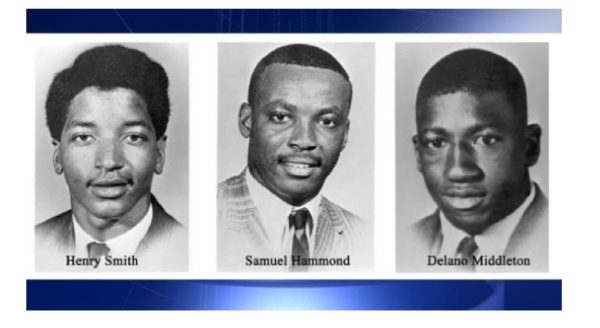Justice Department Continues to Look at 20 Cold Cases from the Civil Rights Era; 13 of Which Are Police-Involved Killings In Southern States
This week the United States Justice Department closed its investigation into the death of Emmett Till. Despite finding no new evidence to bring new charges in the 14-year-old’s 1955 lynching, the FBI’s Cold Case Initiative continues to investigate other cold-case crimes with racial bias implications from the civil rights movement era.
The Justice Department Cold Case Initiative was founded by the FBI in 2006. The mission of this department is to “identify and investigate racially-motivated murders committed decades ago.” The program was influential in getting the Emmett Till Unsolved Civil Rights Crime Act (“Emmett Till Act”) passed and signed into law on Oct. 8, 2008.
Three Black students, Henry Smith, Samuel Hammond Jr. and Delano B. Middleton, were shot to death during the Orangeburg Massacre. Credit: ABC 4 News Screengrab
Through partnerships with the National Association for the Advancement of Colored People (NAACP), the Southern Poverty Law Center (SPLC), and the National Urban League this department has been able to identify over the years unsolved race-related cold cases where the victims might have had their civil rights criminally violated.
The Justice Department reported to Congress in July that 20 cold cases from the ’60s and ’70s where American citizens’ civil rights were violated continue to be investigated by the DOJ. Some 13 of the 20 cases are police-involved killings of Black people in Southern states.
One such case was a 1970 demonstration in Augusta, Georgia, that exploded after a 16-year-old boy named Charles Oatman was killed while in the custody of the county jail. The uprising lasted for two days and included thousands of Black residents protesting in a 7-mile radius. During this act of civil unrest, six Black men were shot by local police, but no one paid a criminal penalty for those deaths.
An all-white jury acquitted the two white officers who were charged with the police-involved shootings that wounded five protestors and resulted in the death of John Stokes. The DOJ could determine that the victims’ federal civil rights were violated in those shootings.
Other cases under further review is the slayings of seven Black men who were active in student protests in South Carolina, Mississippi, and Louisiana during the civil rights movement. These killings are also unresolved.
One of the notable killings connected to the aforementioned student protests is the Orangeburg Massacre at South Carolina State in 1968 where three individuals were shot by police.
All the young men killed were students: Sammy Hammond, Delano Middleton, and Henry Smith.
Hammond, a freshman at S.C. State, was shot in the back by one of the officers. Middleton, a 17-year-old high school student whose mother worked at the institution, was shot seven times. Lastly, 18-year-old Smith was shot three times. Nine out of 70 armed officers at the school were charged and tried for shooting the unarmed protestors.
All of these men were acquitted, even though U.S. Attorney General Ramsey Clark said that the police had lost self-control and “committed murder.” The Cold Case Initiative is reviewed to see if Clark was correct in his assessment.
Another campus protest that the state will further review is the 1970 Jackson State demonstration, where two young men, Phillip Gibbs and James Earl Green, were killed after police let off a 28-second barrage of gunfire into a crowd of restless students. At the time of his demise, Green was not a student at the school like Gibbs but was still in high school looking forward to his graduation a few days later.
The President’s Commission on Campus Unrest later found that the shootings were “an unreasonable, unjustified overreaction,” and acknowledged that “racial antagonisms” were at the root of the conflict between the police and the students. Still, two grand juries, one local and one federal, chose not to indict any officers connected to the death of the two youths.
The agency aims to also find justice for Leonard Brown and Denver Smith, who were killed during the Southern University protest in 1972, captured in the 2018 PBS film “Tell Them We Are Rising: The Story of Black Colleges and Universities.”
According to reports, the students and the state police were at war, but not Smith. He was not politically active. His sister, Josephine Smith-Jones noted that she was the reason he was there. “He (Denver Smith) was never part of the movement at all,” she told the outlet three years ago. “If I hadn’t been involved, my brother would never have been there.” Like so many other cases reviewed by the department, no one was prosecuted in these murders.
The youngest victim of one of these cold cases that are being investigated is 9-year-old Donna Reason. In 1970, a Molotov cocktail was thrown into her Chester, PA home’s living room. The suspicion according to police is that the Reason’s family were not the intended targets at all. Law enforcement, who was assigned to guard a local district justice of the peace, thinks the culprits meant to assault the judge,
An article from The Daily Courier reported the story on May 20, 1970, and said the bombing happened “shortly before midnight.” Reason’s father tried to save her during the fire, but the girl broke away from him and half-sleep she mumbled, “I have to go to school.” Somehow, she lost her balance and fell down the stairs and into the fiery living room where the bomb touched ground.
Fifty-one years later, no one has been charged for the death of the grammar school student.
The FBI’s Close Case Initiative, under the Emmett Till Unsolved Civil Rights Crime Act, is hoping to find justice in all of these cases.
More news from our partners:
Former NFL Head Coach Hue Jackson Takes Over At Grambling State | Coach Prime Effect Is Real

